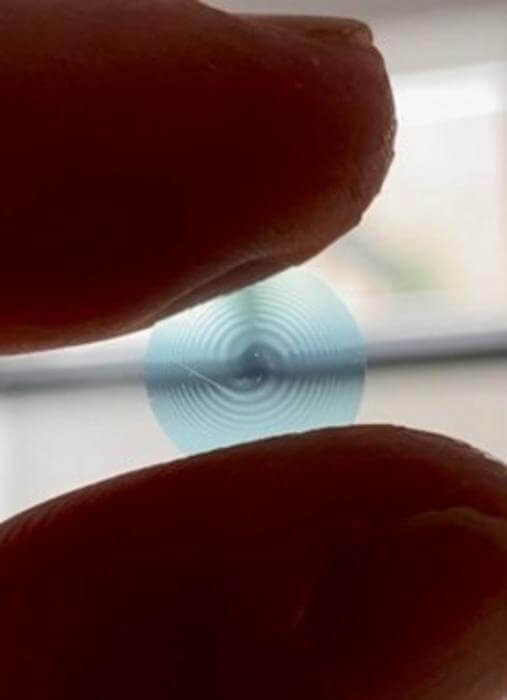WASHINGTON — A groundbreaking new spiral-shaped lens could significantly enhance eyewear technology by offering “clear vision” across a range of distances and under various lighting conditions. According to scientists, this innovation has the potential to benefit individuals with cataracts or age-related vision issues.
Scientists from France explain that this lens functions similarly to progressive lenses, which are used for vision correction but without the typical distortions associated with those lenses. The research team suggests that this development could pave the way for advancements in contact lens technology, intraocular implants for cataract treatment, and the miniaturization of imaging systems.
“Unlike existing multifocal lenses, our lens performs well under a wide range of light conditions and maintains multifocality regardless of the size of the pupil,” says Bertrand Simon from Photonics, Numerical and Nanosciences Laboratory (LP2N), a joint research unit between the Institut d’Optique Graduate School, the University of Bordeaux and the CNRS in France, in a media release. “For potential implant users or people with age-related farsightedness, it could provide consistently clear vision, potentially revolutionizing ophthalmology.”
Researchers are calling this new lens a “spiral diopter.” Its spiraling features are arranged to create many separate points of focus, much like having multiple lenses in one, making it possible to see clearly at various distances.
“In addition to ophthalmology applications, the simple design of this lens could greatly benefit compact imaging systems,” Simon says. “It would streamline the design and function of these systems while also offering a way to accomplish imaging at various depths without additional optical elements. These capabilities, coupled with the lens’s multifocal properties, offer a powerful tool for depth perception in advanced imaging applications.”
💡How Common Are Vision Problems?
- The World Health Organization says:
- 2.2 billion people have a near or distance vision impairment
- At least 1 billion of these cases could have been prevented or have yet to be addressed
- Most people with vision impairment and blindness are over the age of 50

The inspiration for the spiral lens design emerged while Laurent Galinier, the paper’s first author from SPIRAL SAS in France, was analyzing the optical properties of patients with severe corneal deformations.
This analysis led him to conceptualize a lens featuring a unique spiral design that causes light to spiral similarly to water swirling down a drain. This effect, known as an “optical vortex,” generates multiple clear focal points, enabling the lens to provide sharp focus at various distances.
“Creating an optical vortex usually requires multiple optical components,” Galinier explains. “Our lens, however, incorporates the elements necessary to make an optical vortex directly into its surface. Creating optical vortices is a thriving field of research, but our method simplifies the process, marking a significant advancement in the field of optics.”
The research team crafted the lens using advanced digital machining techniques to mold its unique spiral design precisely. To validate the lens, they employed it to capture an image of a digital “E” similar to those displayed on an optometrist’s illuminated board. They observed that the quality of the image remained satisfactory, irrespective of the aperture size utilized.

Additionally, the team discovered that the optical vortices could be modified by adjusting the topological charge, which essentially refers to the number of spirals around the optical axis. Volunteers who tested the lenses reported significant improvements in visual acuity across various distances and lighting conditions.
The successful development of the new lens was achieved by merging the intuitively designed concept with cutting-edge fabrication technologies.
“The spiral diopter lens, first conceived by an intuitive inventor, was scientifically substantiated through an intensive research collaboration with optical scientists,” Simon adds. “The result was an innovative approach to creating advanced lenses.”
The researchers are currently focused on gaining a deeper understanding of the unique optical vortices generated by their lens. Furthermore, they intend to conduct systematic trials to evaluate the lens’s ability to correct vision in individuals, aiming to establish its effectiveness and benefits under real-world conditions.
The team is also investigating the potential application of this concept to prescription eyeglasses, which could offer users clear vision at multiple distances.
“This new lens could significantly improve people’s depth of vision under changing lighting conditions,” Simon concludes. “Future developments with this technology might also lead to advancements in compact imaging technologies, wearable devices and remote sensing systems for drones or self-driving cars, which could make them more reliable and efficient.”
The new lens is described in the journal Optica.
You might also be interested in:
SWNS writer Stephen Beech contributed to this report.

vision for millions with eye problems
When will it be available to purchase?
I just want to know how I can get in on the clinical trials. If anyone is seeing this and knows where the clinical trials are being held sign me up!
👋🏼 Sign me to help with clinical trials. Have severe astigmatism, will travel 🧳